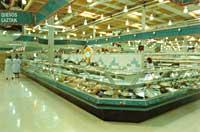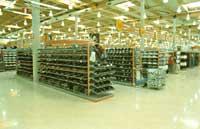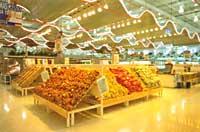Merchandising: appropriate product in the right place
What is merchandising
One of the oldest trades in the world... Wasn't that merchant of the Arab fair merchandising when, in ancient times, he put his bright oranges in a heap and showed the two most beautiful oranges in half? Xupu drops flashed under the summer sun, causing the buyer to thirst. Was it not the best product demonstration?

However, the teaching of these traders was not attended by those who, across the counter, sold to the customer. The relationship between product and customer was limited: the counter was often an insurmountable wall. For the benefit of the customer and the seller, “large surface stores”, supermarkets, hypermarkets, have been created... because large productions must be sold and help the consumer in the purchase of the products.
On the other hand, the consumer prefers to choose the product for himself: nowadays it is usually said that it is bought more by hand than money. Therefore, the product is increasingly close to the consumer. Currently the seller has no role in the purchase and you can say that the consumer is “free”. The consequence of all this is that the product itself has to be sold to the consumer. What product do we choose? We will consider the brand and quality.
Advertising also has something to say, but we are increasingly less faithful to excessive advertising. If the seller has another alternative: lower prices, but with the margins of sale increasingly reduced, ... The only solution left to the seller is the location of the goods, the environment of the product, the environment… That is the merchandising.
Let's buy

Vendors know that we have entered the age of leisure. That is why the merchandisers have tried to make the purchase as pleasant as possible: the friendlier the purchase, the more time we spend inside; the more time inside, the more we buy. But how to get it? Good lighting, extensive tours and pleasant music are essential. Anything else? Have you ever noticed that access doors to hypermarkets are located to the right of payment boxes? It seems that when we walk we tend to the right. Aware of this, traders want the journey we make within trade to be as long as possible. And once inside the point of sale, how should the products be placed?
The first criterion to consider is the type of product: you have to see if it is products that are bought thinking, products that are bought with whims or products that are bought thinking very well. It is also necessary to take into account the “type of traffic” or the march of the public that is in every corner of the point of sale, that is, if it is traffic with destination or traffic to the drift.
Nor will the compactness of this traffic be excluded. That's why appliances, books, toys, and products that are bought in general need a quiet place, choosing the right side of hypermarkets. Why? The first area that arrives is the right. We enter without haste because we have little burden: the best time to see, compare and discuss whether or not to buy with women, children or parents.

On the other hand, it has been shown that this right part is one of the quietest areas, so it is perfect to think well about buying. Where should these products be placed on the list of homemade products (such as dairy, bread and meat)? It is clear that they must be placed as far as possible from the entrance. If not, we would go home without seeing the other products at the point of sale. And as those who do merchandising know a lot, the product that is not seen is not sold. Finally, these products that are put as hooks (chocolates, cookies...) have a large margin, where?
At the entrance no, of course: as we pass by we remember the products of the list. These products will be placed in the way of the boxes, where the traffic is very intense, so that once purchased all the products of the list we can see them and buy them. After buying so many things, we are sure that something has been forgotten. That's why we're going to see the most forgotten products: batteries, razors, ...
Inside these large establishments you can distinguish hot areas (where there are many sales) and cold ones (where sales are low). The box heads, the corners of these long “gondolas” or shelves and the center of the store are usually hot areas where many people pass. It usually places high margin, cheap products (if they are expensive, they would affect us too much to decide whether to buy or not), promotional products and, in general, products that want to sell more. In cold areas the products of the list will be placed: although it is a cold area, it is mandatory to go. It is preferred to have few cold areas.

For this, the columns (have you ever seen them in a big trade?) And other obstacles will be avoided. If cold areas cannot be avoided, they should be tempered. This can be achieved through posters, promotions or tastings.
Once the location of the different sections is fixed, how should the items be placed in the gondolas? There are two options: longitudinal or wide. If the item is placed on all longitudinal or vertical shelves, the customer is given comfort: we will easily search all products. To the widths, but if placed on a single shelf, forces the customer to look up and down. This second option is much more expensive for the customer, so you will leave the point of sale without seeing many products.
But only large hypermarkets have the possibility to put items up and down, as this organization is only profitable when sales are large. At most points of sale, therefore, sales are not enough to put the items up and down. In this sense, the use of a bankrupt organization is frequent. You can already use the organization for widths in circulation places. The gear is usually not very fast, so we look at the products of all shelves. In this type of organization, low visual products are the best sellers. Knowing this, genuine struggles to conquer this bass emerge among the article producing companies. All kinds of advantages, such as sales, are given to the point of sale in exchange for having that shelf. In the lower shelves large items will be placed, easy to see, like diapers.

The merchandising is also responsible for the environment of the point of sale: stands, decorated,... and do not be surprised if you see singers, txarangas or clowns within the trade. On the other hand, there are sections that require special environments. So, for example, employees of the “beauty products” section will be pretty and irritated girls, in the wine section they put on...
Imagine that merchandising is just a big surface thing. It can be used in any type of store or service. In some benches, for example, removing the glass barrier, the client is invited to sit next to a table, with a nice guy willing to explain to the other side of the table the profitability of their products… Everything is done so that the customer is as at home and of course to increase their profits.
As you can see, the merchandising technique offers many resources to consumer services. But does the consumer own all this?





